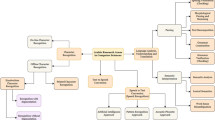Abstract
In this paper, we fill a gap in the literature by studying the problem of Arabic handwritten digit recognition. The performances of different classification and feature extraction techniques on recognizing Arabic digits are going to be reported to serve as a benchmark for future work on the problem. The performance of well known classifiers and feature extraction techniques will be reported in addition to a novel feature extraction technique we present in this paper that gives a high accuracy and competes with the state-of-the-art techniques. A total of 54 different classifier/features combinations will be evaluated on Arabic digits in terms of accuracy and classification time. The results are analyzed and the problem of the digit ‘0’ is identified with a proposed method to solve it. Moreover, we propose a strategy to select and design an optimal two-stage system out of our study and, hence, we suggest a fast two-stage classification system for Arabic digits which achieves as high accuracy as the highest classifier/features combination but with much less recognition time.
Similar content being viewed by others
References
LeCun Y., Bottou L., Bengio Y., Haffner P.: Gradient-based learning applied to document recognition. Proc. IEEE 86(11), 2278–2324 (1998)
Dong, J.: Comparison of algorithms for handwritten numeral recognition. Technical report, CENPARMI, Concordia University, 1999
Liu C.-L., Nakashima K., Sako H., Fujisawa H.: Handwritten digit recognition: benchmarking of state-of-the-art techniques. Pattern Recognit. 36, 2271–2285 (2003)
Zhang, P., Bui, T., Suen, C.Y.: Hybrid feature extraction and feature selection for improving recognition accuracy of handwritten numerals. Proc. 8th ICDAR, pp. 136–140, 2005
Teow L., Loe K.: Robust vision-based features and classification schemes for off-line handwritten digit recognition. Pattern Recognit. 40(6), 1816–1824 (2007)
Belongie, S., Malik, J., Puzicha, J.: Shape matching and object recognition using shape contexts. PAMI, vol. 24, no. 24, 2002
Lauera F., Suen C., Blocha G.: A trainable feature extractor for handwritten digit recognition. Pattern Recognit. 36, 2271–2285 (2003)
Gorgevik, D., Cakmakov, D.: An efficient three-stage classifier for handwritten digit recognition. Proc. 17th ICPR, pp. 1051–4651 (2004)
Al-Omari F., Al-Jarrah O.: Handwritten Indian numerals recognition system using probabilistic neural networks. Adv. Eng. Inform. 18(1), 9–16 (2004)
Said, F., Yacoub, R., Suen, C.: Recognition of English and Arabic numerals using a dynamic number of hidden neurons. Proc. 5th ICDAR, pp. 237–240, 1999
El-Sherif, E., Abdelazeem, S.: A two-stage system for Arabic handwritten digit recognition tested on a new large database. International Conference on Artificial Intelligence and Pattern Recognition (AIPR-07), Orlando, FL, USA, July 2007, pp. 237–242
Mozaffari, S., Faez, K., Ziaratban, M.: Structural decomposition and statistical description of Farsi/Arabic handwritten numeric characters. Proc. 8th ICDAR, pp. 237–241, 2005
Soltanzadeh H., Rahmati M.: Recognition of Persian handwritten digits using image profiles of multiple orientations. Pattern Recognit. Lett. 25(14), 1569–1576 (2004)
Duda R., Hart P., Strok D.: Pattern Recognition, 2nd edn. Wiley, New York (2000)
Webb A.: Staistical Pattern Recognition, 2nd edn. Wiley, New York (2002)
Furnkranz, J.: Round robin classification. J. Mach. Learn. Res., vol. 2, pp. 721–747, 2002
Friedman, J.: Another approach to polychotomous classification. Technical Report, Stanford University, 1996
Bennett K.P., Mangasarian O.L.: Multicategory discrimination via linear programming. Optim. Methods Softw. 3, 27–39 (1994)
Cortes C., Vapnik V.: Support vector networks. Mach. Learn. 20(3), 273–297 (1995)
Gonzales R.C., Woods R.E.: Digital image processing, 2nd edn. Addison-Wesley, Reading, MA, USA (2002)
Zhang, D., Lu, G.: Review of shape representation and description techniques. Pattern Recognit., vol. 37, 2004
Zhang, P., Bui, T., Suen, C.: Hybrid feature extraction and feature selection for improving recognition accuracy of handwritten numerals. Proc. 8th ICDAR, 2005
Trier O.D., Jain A.K., Taxt T.: Feature extraction methods for character recognition—a survey. Pattern Recognit. 29(4), 641–662 (1996)
Hanmandlu, M., Kumar, H., Mohan, K.: Neural based handwritten character Recognition. Proc 5th, ICDAR, p. 241, 1999
de Oliveira, J., de Carvalho, J., Freitas, C., Sabourin, R.: Feature sets evaluation for handwritten word recognition using a baseline system. Proc. 8th IWFHR, pp. 446–451, 2002
Hsu C., Lin C.: A comparison of methods for multi-class support vector machines. IEEE Trans. Neural Netw. 1(13), 415–425 (2002)
Kaynak, C., Alpaydin, E.: MultiStage cascading of multiple classifiers: one man’s noise is another man’s data. Proc. 17th ICML, pp. 455–462, (2000)
Alpaydin, E., Kaynak, C., Alimoglu, F.: Cascading multiple classifiers and representations for optical and pen-based handwritten digit recognition. Proc. 7th IWFHR, pp. 453–462, 2000
Price, D., Knerr, S., Personnaz, L., Dreyfus, G.: Pairwise neural network classifiers with probabilistic outputs. NIPS, pp. 1109–1116, 1995
Platt, J.: Probabilistic outputs for support vector machines and comparison to regularized likelihood methods. In: Smola, A., Bartlett, P., Scholkopf, B., Schuurmans, D. (eds.) Advances in Large Margin Classifiers. Cambridge, MA, pp. 61–74, 2000
Davies E.R.: Machine Vision: Theory, Algorithms, Practicalities. Morgan Kaufmann Publishers Inc., San Francisco, CA (2004)
Author information
Authors and Affiliations
Corresponding author
Rights and permissions
About this article
Cite this article
Abdleazeem, S., El-Sherif, E. Arabic handwritten digit recognition. IJDAR 11, 127–141 (2008). https://doi.org/10.1007/s10032-008-0073-5
Received:
Revised:
Accepted:
Published:
Issue Date:
DOI: https://doi.org/10.1007/s10032-008-0073-5




